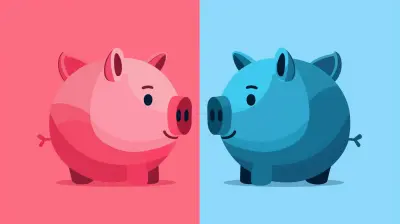7 March 2025
Saving for retirement can feel like climbing a mountain, but doing it while paying off debt? That might seem like scaling Mount Everest with a backpack full of bricks. It’s no wonder so many people feel overwhelmed when faced with this financial double whammy. But here’s the thing—you don’t have to choose between the two. With a solid plan, a little patience, and the right mindset, you can absolutely tackle both at the same time.
Not sure where to begin? Don’t worry; I’ve got your back. In this article, we’ll break it all down step by step, so you can take control of your financial future without feeling like you’re drowning in numbers.

Why Is It Important to Save for Retirement While Paying Off Debt?
First, let’s talk about why this is even necessary. You might be thinking, “Shouldn’t I focus on paying off debt first and then worry about retirement later?” It’s a fair question, but here’s the deal: waiting too long to save for retirement could cost you big time.Time is your best friend when it comes to saving for retirement, thanks to the magic of compound interest. The earlier you start, the more your money has a chance to grow. On the flip side, debt—especially high-interest debt like credit cards—can pile up quickly if you’re only making minimum payments. Ignoring either one for too long could leave you in a tough spot down the road.
So, rather than picking sides, the goal is to strike the right balance. Think of it like walking a financial tightrope. Sounds tricky? Sure, but it’s doable. 
Step 1: Assess Your Financial Situation
Before you can figure out how to juggle saving for retirement and paying off debt, you’ve got to understand where you stand financially. Grab a cup of coffee, sit down with your bank statements, and take an honest look at your income, expenses, and debts.What to Consider:
- Your Debt: List all your debts, including credit cards, student loans, car loans, and mortgages. Note interest rates and minimum payments.- Emergency Savings: Do you have at least 3-6 months’ worth of expenses set aside for emergencies? If not, that’s something to work on, too.
- Retirement Contributions So Far: If you’ve already started saving for retirement, check your balances and see if your employer offers a matching 401(k) contribution.
Pro tip: Use tools and apps to track your spending—they’re like having a helpful friend keeping an eye on your wallet. 
Step 2: Prioritize High-Interest Debt
Not all debt is created equal. High-interest debt, like credit cards, is like the financial equivalent of quicksand—it’ll pull you down fast if you don’t tackle it head-on.Why Eliminate High-Interest Debt First?
Let’s say your credit card charges 18% interest. Ouch, right? Compare that to the average return of 8-10% in a retirement account. If you’re consistently losing more to debt interest than you’re earning in retirement investments, you’re in a losing game.Focus on paying off high-interest debt as quickly as possible. Methods like the Debt Avalanche (paying off the highest interest rate debt first) or the Debt Snowball (paying off the smallest balances first for psychological wins) can help you stay disciplined. 
Step 3: Take Advantage of Free Money
If your employer offers a 401(k) with matching contributions, that’s free money on the table. You don’t want to leave it there!How Does Employer Matching Work?
Say your employer matches up to 4% of your salary. If you contribute 4%, they’ll match it fully, effectively doubling your contribution. That’s a 100% return on investment right out of the gate!Even if you’re laser-focused on paying off debt, contribute enough to get the full employer match. It’s like finding free cash in your pocket—it’d be silly not to take it.
Step 4: Create a Balanced Budget
Now comes the fun part (okay, “fun” might be a stretch, but work with me): creating a budget that lets you save for retirement and pay off debt without losing sleep.How to Divide Your Income
Here’s a simple way to break it down:1. Minimum Debt Payments: You’ve got to keep up with these to avoid penalties and hits to your credit score.
2. Retirement Contributions: Aim for at least enough to get your employer match (if available).
3. Extra Payments for Debt: Any leftover cash should go toward tackling high-interest debt.
The 50/30/20 Rule
Struggling to figure out how much to allocate? Try the 50/30/20 rule:- 50% for essentials (rent, groceries, utilities)
- 30% for wants (yes, you can still enjoy life a little)
- 20% for savings and debt repayment
Step 5: Boost Your Income
If balancing savings and debt feels impossible, it might be time to look at the other side of the equation: your income. Increasing your cash flow can make a world of difference.Ways to Earn Extra Cash:
- Side Hustles: Drive for a rideshare service, freelance, sell handmade crafts—the possibilities are endless.- Ask for a Raise: If you’ve been crushing it at work, now might be the time to negotiate for more pay.
- Sell Unused Items: That old bike or stack of forgotten DVDs could bring in some quick cash.
Step 6: Establish an Emergency Fund
Before you go all-in on retirement savings or debt repayment, make sure you’ve got a safety net in place. Life happens—cars break down, medical bills pop up, and you don’t want to end up relying on credit cards to cover unexpected costs.How Much Should You Save?
Aim for 3-6 months’ worth of living expenses. Start small if you need to—even $1,000 can be a lifesaver in a pinch.Step 7: Automate Everything
Let’s be real—life is busy. The less you have to think about managing your money, the better. That’s where automation comes in.- Automate Retirement Contributions: Set up automatic transfers to your 401(k) or IRA. You won’t miss what you don’t see.
- Automate Debt Payments: Schedule payments so you never forget a due date.
Automation makes consistency easy, and consistency is key to hitting your financial goals.
Step 8: Celebrate Small Wins
This journey can feel like a marathon, not a sprint. That’s why it’s important to celebrate small victories along the way. Paid off a credit card? Treat yourself (within reason). Hit a retirement milestone? Take a moment to appreciate how far you’ve come.Financial success is about progress, not perfection.
Final Thoughts
Saving for retirement while paying off debt might seem like juggling flaming swords, but it’s all about finding balance. Start by understanding your financial picture, prioritize high-interest debt, and take advantage of free money like employer matches. From there, create a budget, boost your income, and automate your efforts to stay on track.Remember, there’s no one-size-fits-all approach. What works for someone else might not work for you, and that’s okay. The key is to stay consistent and give yourself grace along the way. With the right mindset and a solid plan, you can achieve financial freedom and secure your future.










Ariella McAlister
Balance debt repayment and retirement savings for financial security.
April 8, 2025 at 4:48 AM